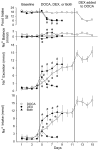Glucocorticoids increase salt appetite by promoting water and sodium excretion
- PMID: 17596327
- PMCID: PMC2922067
- DOI: 10.1152/ajpregu.00294.2007
Glucocorticoids increase salt appetite by promoting water and sodium excretion
Abstract
Glucocorticoids [e.g., corticosterone and dexamethasone (Dex)], when administered systemically, greatly increase water drinking elicited by angiotensin and sodium ingestion in response to mineralocorticoids [e.g., aldosterone and deoxycorticosterone acetate (DOCA)], possibly by acting in the brain. In addition, glucocorticoids exert powerful renal actions that could influence water and sodium ingestion by promoting their excretion. To test this, we determined water and sodium intakes, excretions, and balances during injections of Dex and DOCA and their coadministration (DOCA+Dex) at doses commonly employed to stimulate ingestion of water and sodium. In animals having only water to drink, Dex treatment greatly increased water and sodium excretion without affecting water intake, thereby producing negative water and sodium balances. Similar results were observed when Dex was administered together with DOCA. In animals having water and saline solution (0.3 M NaCl) to drink, Dex treatment increased water and sodium excretion, had minimal effects on water and sodium intakes, and was associated with negative water and sodium balances. DOCA treatment progressively increased sodium ingestion, and both water and sodium intakes exceeded their urinary excretion, resulting in positive water and sodium balances. The combination of DOCA+Dex stimulated rapid, large increases in sodium ingestion and positive sodium balances. However, water excretion outpaced total fluid intake, resulting in large, negative water balances. Plasma volume increased during DOCA treatment and did not change during treatment with Dex or DOCA+Dex. We conclude that increased urinary excretion, especially of water, during glucocorticoid treatment may explain the increased ingestion of water and sodium that occurs during coadministration with mineralocorticoids.
Figures






Similar articles
-
Effects of aging on mineralocorticoid-induced salt appetite in rats.Am J Physiol Regul Integr Comp Physiol. 2013 Dec 15;305(12):R1498-505. doi: 10.1152/ajpregu.00349.2013. Epub 2013 Oct 16. Am J Physiol Regul Integr Comp Physiol. 2013. PMID: 24133100 Free PMC article.
-
Inhibition of NaCl appetite when DOCA-treated rats drink saline.Am J Physiol Regul Integr Comp Physiol. 2007 Jan;292(1):R652-62. doi: 10.1152/ajpregu.00055.2006. Epub 2006 Sep 21. Am J Physiol Regul Integr Comp Physiol. 2007. PMID: 16990496
-
Sodium retention and salt appetite following deoxycorticosterone in hamsters.Am J Physiol. 1983 Jan;244(1):R78-83. doi: 10.1152/ajpregu.1983.244.1.R78. Am J Physiol. 1983. PMID: 6849421
-
Mineralocorticoids and glucocorticoids cooperatively increase salt intake and angiotensin II receptor binding in rat brain.Neuroendocrinology. 1999 May;69(5):339-51. doi: 10.1159/000054436. Neuroendocrinology. 1999. PMID: 10343175
-
DOCA stimulates salt appetite in Zucker rats: effect of dose, synergistic action with central angiotensin II, and obesity.Brain Res Bull. 2007 Sep 14;74(1-3):14-20. doi: 10.1016/j.brainresbull.2007.04.001. Epub 2007 Apr 26. Brain Res Bull. 2007. PMID: 17683784
Cited by
-
Effects of aging on mineralocorticoid-induced salt appetite in rats.Am J Physiol Regul Integr Comp Physiol. 2013 Dec 15;305(12):R1498-505. doi: 10.1152/ajpregu.00349.2013. Epub 2013 Oct 16. Am J Physiol Regul Integr Comp Physiol. 2013. PMID: 24133100 Free PMC article.
-
Dexamethasone-induced insulin resistance: kinetic modeling using novel PET radiopharmaceutical 6-deoxy-6-[(18)F]fluoro-D-glucose.Mol Imaging Biol. 2014 Oct;16(5):710-20. doi: 10.1007/s11307-014-0737-0. Mol Imaging Biol. 2014. PMID: 24819311 Free PMC article.
-
Downregulation of UT-A1/UT-A3 is associated with urinary concentrating defect in glucocorticoid-excess state.J Am Soc Nephrol. 2008 Oct;19(10):1975-81. doi: 10.1681/ASN.2008010051. Epub 2008 Jul 30. J Am Soc Nephrol. 2008. PMID: 18667732 Free PMC article.
-
Nocturia and obstructive sleep apnoea.Nat Rev Urol. 2024 Dec;21(12):735-753. doi: 10.1038/s41585-024-00887-7. Epub 2024 May 23. Nat Rev Urol. 2024. PMID: 38783115 Review.
-
Effects of Black Garlic Extract and Nanoemulsion on the Deoxy Corticosterone Acetate-Salt Induced Hypertension and Its Associated Mild Cognitive Impairment in Rats.Antioxidants (Basel). 2021 Oct 13;10(10):1611. doi: 10.3390/antiox10101611. Antioxidants (Basel). 2021. PMID: 34679745 Free PMC article.
References
-
- Baylis C, Handa RK, Sorkin M. Glucocorticoids and control of glomerular-filtration rate. Semin Nephrol. 1990;10:320–329. - PubMed
-
- Braun-Menendez E. Aumento del apetido especifico para la sal provocado por la desoxicorticosterona: sustancias que potencian o inhibiten esta accion. Rev Soc Arg Biol. 1952;28:23–32. - PubMed
-
- Daniels D, Fluharty SJ. Salt appetite: a neurohormonal viewpoint. Physiol Behav. 2004;81:319–337. - PubMed
-
- Epstein AN. Mineralocorticoids and cerebral angiotensin may act together to produce sodium appetite. Peptides. 1982;3:493–494. - PubMed
-
- Fitts DA. Effects of lesions of the ventral ventral median preoptic nucleus or subfornical organ on drinking and salt appetite after deoxycorticosterone acetate or yohimbine. Behav Neurosci. 1991;105:721–726. - PubMed
Publication types
MeSH terms
Substances
Grants and funding
LinkOut - more resources
Full Text Sources
Other Literature Sources
Medical

